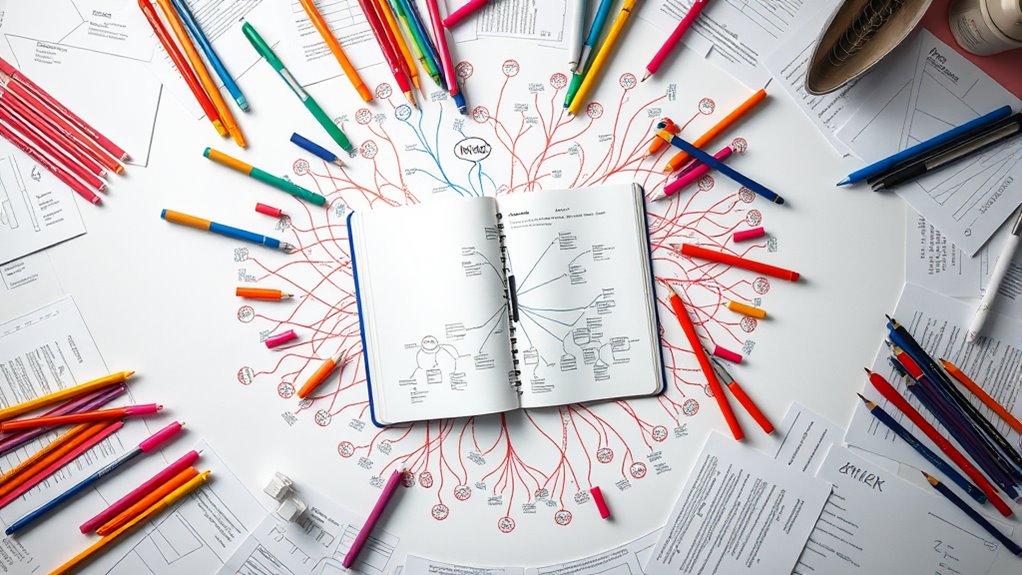Mind mapping is a visual tool that helps you organize ideas clearly and efficiently by creating a web of interconnected thoughts. It allows you to see connections and patterns, making complex information easier to understand and remember. Using colors, images, and symbols, you can spark creativity and develop new insights. This flexible technique supports ongoing idea development and problem-solving, turning chaos into clarity. Keep exploring to discover how mastering mind mapping can transform your organization skills.
Key Takeaways
- Mind mapping visually organizes ideas by connecting related concepts around a central theme, enhancing clarity.
- It reveals hidden connections and patterns, aiding better understanding and decision-making.
- Using colors, images, and symbols makes ideas more memorable and stimulates creativity.
- It supports ongoing revision and expansion, fostering continuous idea development.
- Ideal for diverse tasks like project planning, brainstorming, and problem-solving, improving overall organization.

Have you ever struggled to organize your thoughts or brainstorm ideas effectively? If so, you’re not alone. Many people find it challenging to turn scattered ideas into a clear plan or creative insight. That’s where mind mapping comes in—a powerful tool that helps you visualize your ideas and see connections you might otherwise miss. When you start using mind mapping, you tap into effective brainstorm techniques that boost your creativity enhancement. Instead of jotting down random notes or trying to remember everything in your head, a mind map lets you lay out your thoughts visually, making it easier to identify patterns, prioritize ideas, and develop new concepts.
Using mind maps, you can create a central idea or problem in the middle of a page or digital canvas. From there, you branch out with related themes, sub-ideas, or steps, forming a web of interconnected thoughts. This structure not only clarifies your thinking but also stimulates your creative process. By organizing ideas visually, you’re more likely to see gaps, overlaps, or fresh angles that weren’t obvious before. This approach enhances your ability to generate ideas quickly and efficiently, making it an excellent technique for brainstorming sessions. It encourages free thinking while keeping your focus organized, which ultimately leads to better problem-solving and innovation.
Create interconnected ideas with mind maps to clarify thinking and spark creativity.
The beauty of mind mapping lies in its versatility. Whether you’re planning a project, writing a paper, or developing a new business idea, this method adapts seamlessly to your needs. As you expand your map, you’re engaging multiple parts of your brain—visual, logical, and creative—leading to a richer, more integrated thought process. You can add colors, images, or symbols to make your mind map more engaging and memorable, further enhancing your creativity. These visual cues can trigger new associations or insights, helping you break through mental blocks or stagnation. Additionally, visual learning plays a significant role in how mind maps strengthen your ability to retain information and foster innovative thinking.
Moreover, mind mapping isn’t just about capturing ideas; it’s a dynamic process that evolves as your understanding deepens. You can easily revise, reorganize, or expand your map without losing your previous work. This flexibility encourages continuous idea development, making it easier to refine your thoughts and approach. Over time, practicing mind mapping can profoundly improve your ability to brainstorm efficiently, develop innovative solutions, and organize complex information with clarity. If you want to access your full creative potential, incorporating mind mapping into your routine is a smart move—one that transforms chaos into clarity and ideas into actionable plans.
Frequently Asked Questions
How Does Mind Mapping Improve Memory Retention?
Mind mapping improves your memory retention by enhancing visual memory and making information recall easier. When you create a mind map, you actively organize ideas visually, which helps your brain connect concepts more effectively. This process engages both your creative and analytical thinking, making it easier to remember details later. By simplifying complex information into clear, visual chunks, you strengthen your ability to recall key points quickly and accurately.
Can Mind Mapping Be Used for Team Collaboration?
Think of mind mapping as a bridge connecting team members’ ideas. You can use it as an effective brainstorming technique for remote collaboration, allowing everyone to visually share and develop concepts in real-time. It encourages active participation, clarifies complex thoughts, and fosters innovation across distances. By incorporating mind maps into your teamwork, you create a dynamic space where ideas flow freely, making collaboration more engaging and productive.
What Are the Best Digital Tools for Creating Mind Maps?
You should try tools like MindMeister, XMind, or Coggle for creating digital mind maps. These platforms support brainstorming techniques and enhance visual organization, making it easier for you to develop and share ideas. They offer real-time collaboration, customizable layouts, and easy exporting options. Using these tools helps you streamline your thought process and communicate complex concepts clearly, boosting productivity and creativity in your projects.
How Do I Start a Mind Map for Complex Projects?
Imagine you’re a detective in the 1800s, piecing together clues. To start your intricate project mind map, first identify main themes or goals. Use brainstorm techniques like free association to generate ideas quickly. Then, organize these ideas visually by creating branches for each theme, connecting related concepts. This visual organization helps clarify relationships, making it easier to manage intricate details and develop a clear, all-encompassing plan.
Are There Age-Specific Tips for Effective Mind Mapping?
Yes, age-specific techniques matter for effective mind mapping. For children, use colorful visuals, simple words, and engaging images to match their developmental considerations. Teenagers benefit from more complex, abstract ideas and digital tools to enhance creativity. Adults should focus on clear organization, concise labels, and integrating their existing knowledge. Tailoring your approach to age-specific techniques boosts engagement and helps you better visualize ideas, regardless of your developmental stage.
Conclusion
By using mind mapping, you can turn chaotic thoughts into clear, organized ideas. Imagine you’re planning a wedding; with a mind map, you quickly see all tasks—from choosing a venue to sending invites—laid out visually. This approach helps you stay focused and reduces stress. So, start creating your own mind maps today and see how effortlessly your ideas come together, making any project feel more manageable and enjoyable.









